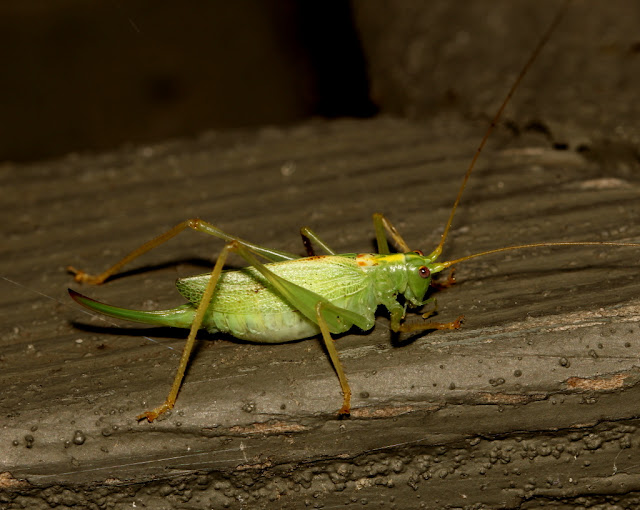I’ve never written a blog post that does not include some of my field recordings. After all, this is “Listening in Nature!” But did you know there are a few crickets and katydids that do not sing? I’ve had people ask me about them this year, so I thought this might be a good time to introduce you to two non-singers you may find in NE Ohio.
The first is this pretty little European katydid: Meconema thalassinum, the Drumming Katydid.
It doesn’t “sing” in the same way as other katydids. Instead, it taps a back foot on a leaf! Have I actually heard this sound? No, I have not, but I did find a recording of its foot-tapping performance here. The song illustration in Singing Insects of North American matches the recording quite well.
It’s common across much of Europe, where it's called the Oak Bush Cricket. You’ll find more information about this species if you search for it by that name. They live in trees and do indeed seem to be fond of oaks.
I typically find them on human structures made of wood, such as a porch, a shed, or a park shelter. The first one I discovered was on my car and it probably had been on the large pin oak next to the driveway. I usually find one on the front porch in mid-July, apparently attracted to the light we leave on until late at night.
Wendy and I even spotted one on a Cleveland Heights hen house!
According to the Singing Insects of North America, "It lays its eggs in crevices in bark and may have been imported to the United States as eggs on woody ornamental plants. Whatever the means, by 1957 it had become established on western Long Island, New York, and by 1980 it had extended its range to Rhode Island and to Scarsdale and Ithaca, New York.”
They're not abundant, and they certainly don’t seem to cause any trouble. In fact, gardeners may appreciate that they eat aphids!
My other non-singer also eats aphids other small insects as well. It’s the Carolina Leaf Roller, Camptonotus carolinensis.
The first, second, and third thing you are likely to notice are the antennae. Don’t they seem almost ridiculously long?
They don’t have wings, and their bodies remind me somewhat of camel crickets that we occasionally find in rock formations.
They are “leaf rollers” because they do indeed roll up a leaf to create a shelter. From BugGuide: (The cricket) “bites through leaf in order to form flap. Flap is folded over, edge is pulled down with legs, and then edges are glued together with silk from gland on mouth. Sometimes uses the pods of Bladdernut as a shelter instead of a leaf.” (The original source appears to be How to Know the Grasshoppers, Cockroaches, and their Allies by Jaques Helfer.)
The Carolina Leaf Roller is a native species that’s more common in the southeast. I’ve seen them in southern Ohio, but not typically in NE Ohio. This year, however, I found them in both Medina and Summit Counties south of Cleveland.
And are they ever active! They move quickly, jump extremely well, and can be found in lower vegetation or in trees. In my absolutely subjective assessment, they are adorably cute and absolutely entertaining to watch.
Let’s just take a closer look, especially since we’re not going to take a closer listen to silent crickets. Here's a mating pair.
Both sexes are an attractive golden orange color.
Females have a dark circle around the base of their bodies that reminds me of a wasp or bee.
Females have a dark circle around the base of their bodies that reminds me of a wasp or bee.
These photos were taken at Letha House Park in the Medina (County) Park District. I was fortunate to see three of them undergoing what I assume to be their final molt near the edge of one of the restored wetlands on August 1st.
This was not a habitat I would have thought to search for them, as I’d only seen them in shrubs and the lower branches of trees, but it certainly made them easier to observe.
In my next post, I’ll return to insects that sing, but you’ll remember this silent, but attractive cricket and katydid pair until next year, won’t you?
This was not a habitat I would have thought to search for them, as I’d only seen them in shrubs and the lower branches of trees, but it certainly made them easier to observe.
In my next post, I’ll return to insects that sing, but you’ll remember this silent, but attractive cricket and katydid pair until next year, won’t you?
I’ll close my non-singer post with a photo of one particularly charming female Carolina Leaf Roller. It was from her that I learned how quickly they move and how delightful they are - even if they don't sing!
















No comments:
Post a Comment